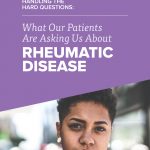A chapter from HANDLING THE HARD QUESTIONS:
What Our Patients Are Asking Us About Rheumatic DiseaseRead and download this booklet on our Workforce Resource homepage
Each day, rheumatology nurses, nurse practitioners, and physician assistants field dozens of questions from their patients with rheumatic diseases, and they need to be able to properly and effectively communicate appropriate responses. This pocket guide includes a brief summary of evidence surrounding some of the most common—and challenging—questions that patients with rheumatoid arthritis, psoriatic arthritis, gout, and systemic lupus erythematosus are asking about. We hope you find this guide useful for your professional development and that it assists you with your day-to-day patient management.
How did I get psoriatic arthritis (PsA)?
As with other autoimmune diseases, there is no single factor that we can attribute to your development of psoriatic arthritis (PsA).
PsA is a chronic inflammatory arthritis, although unlike RA, it affects women and men equally. As a heterogenous condition, PsA may involve either a few or many peripheral joints, the entheses (the area where ligaments, joint capsules, or tendons insert into the bone) or axial skeleton, and/or nail dystrophy.1,2 Symptoms may include pain in affected joints or tendons, neck or back pain, dactylitis (swelling of entire digits), morning stiffness that lasts more than an hour or improves with activity, fatigue, and difficulties with activities of everyday living.3 Patients may also have additional symptoms beyond the joints, such as conjunctivitis, colitis, or urethritis.1
Typically, individuals with PsA will also have psoriasis, a chronic skin disease. While estimates vary widely, anywhere from 6% to 41% of patients with psoriasis will develop PsA.2 For the majority of individuals, psoriasis develops before PsA; however, for 15-20% of patients, the signs of arthritis will precede any skin findings.1 Furthermore, some individuals may have PsA in the absence of skin psoriasis; this usually occurs in people who have relatives with psoriasis.3
While the cause of PsA is not entirely clear, it is believed to be immune-mediated, either as a classic autoimmune disease or as a result of inflammation secondary to trauma or physical stress in the entheseal organ (entheses and surrounding tissues). Like many immune-related conditions, PsA is thought to be due to a combination of genetic predisposition combined with a triggering event of some sort, such as infection, drug use, trauma, smoking, or obesity.1,4,5
References
1. Kerschbaumer A, Fenzl KH, Erlacher L, Aletaha D. An overview of psoriatic arthritis – epidemiology, clinical features, pathophysiology and novel treatment targets. Wien Klin Wochenschr. 2016;128(21-22):791-795.
2. Singh JA, Guyatt G, Ogdie A, et al. Special Article: 2018 American College of Rheumatology/National Psoriasis Foundation guideline for the treatment of psoriatic arthritis. Arthritis Rheumatol. 2019;71(1):5-32.
3. Busse K, Liao W. Which psoriasis patients develop psoriatic arthritis? Psoriasis Forum. 2010;16(4):14.
4. Ogdie A, Weiss P. The epidemiology of psoriatic arthritis. Rheum Dis Clin North Am. 2015;41(4):545-568.
5. Liu JT, Yeh HM, Liu SY, Chen KT. Psoriatic arthritis: Epidemiology, diagnosis, and treatment. World J Orthop. 2014;5(4):537-543

